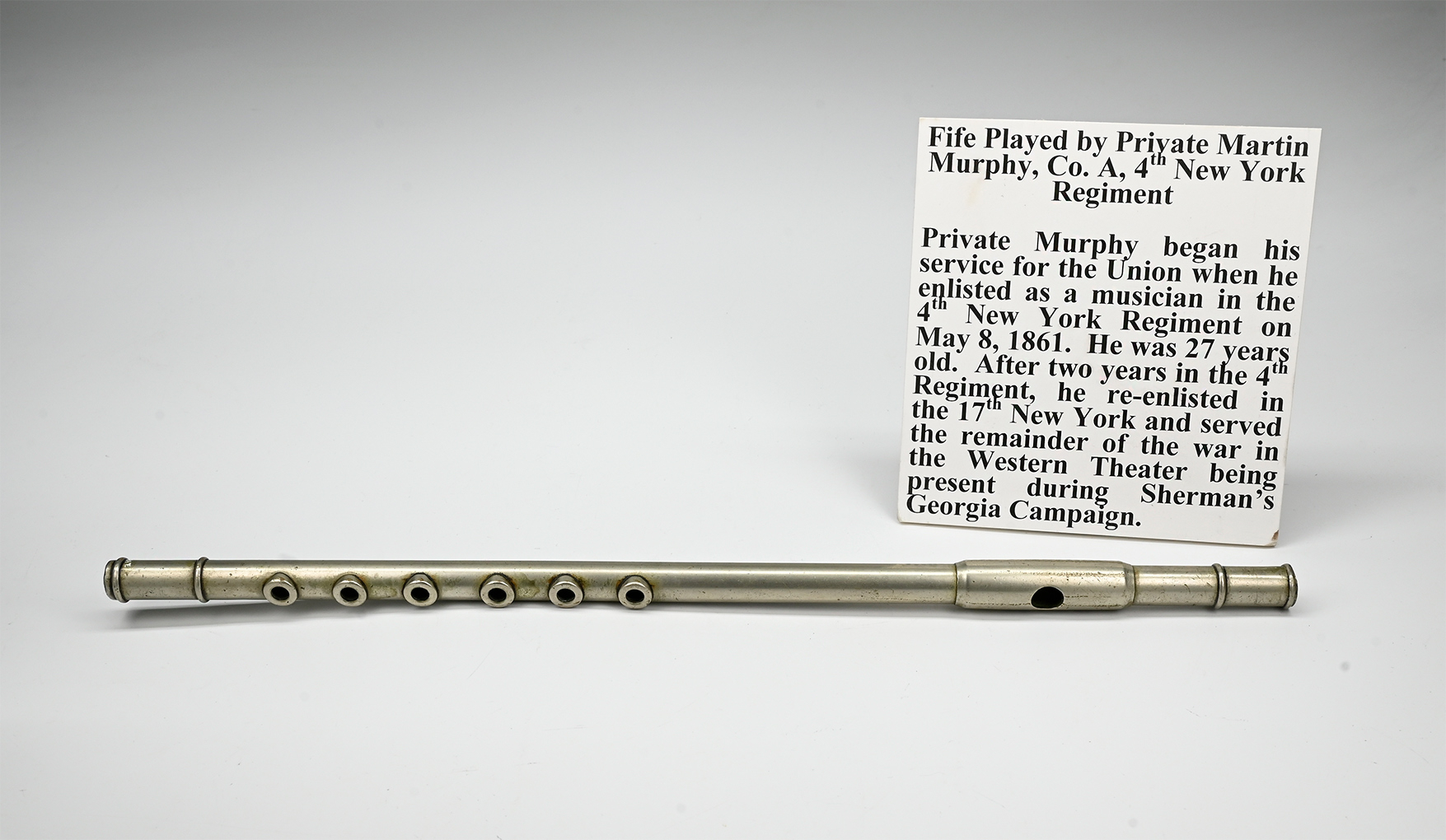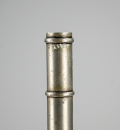site search
online catalog
SILVERED PRESENTATION FIFE TO MARTIN MURPHY, 4th NEW YORK VOLUNTEERS, 17th NY VETERAN ZOUAVES, AND REGULAR ARMY

$4,950.00
Quantity Available: 1
Item Code: 1268-167
Shipping: Determined by Method & Location of buyer
To Order:
Call 717-334-0347,
Fax 717-334-5016, or E-mail
This elegant silvered fife, 15-1/4” long, bears a great presentation and was carried by a company musician with Civil War service in two New York regiments, one of them a zouave regiment, and substantial service in the regular army. He seems to have been one heck of a fifer, or at least well-liked by his comrades. Not only did they present him with this fife, officers on at least two occasions stepped up to get him out of trouble with army authorities- perhaps a tribute to his “Old Army” connections as well.
The presentation is engraved in fine script in two parts: “Presented to / Martin Murphy. / Co. A Scott Life Guard / 4th N.Y.V.” and “Falmouth, Va. / May 8th 1863.” The date indicates it was given to him as something of a parting gift, since the regiment was to muster out May 23, 1863, but Murphy re-enlisted soon after as a veteran volunteer and would have carried it also in his service with the 17th NY Veteran Volunteers, sometimes called the 17th NY Veteran Zouaves, who saw active campaigning in the western theatre, including the Atlanta Campaign, the March to the Sea, etc.
Murphy’s Civil War service began with his enlistment in May 1861 in the 4th New York Volunteers, perhaps not by chance. Nicknamed the “First Scott’s Life Guard,” they were a two-year regiment recruited under the auspices of the “Veteran Scott Life Guard,” an organization of Mexican War veterans, and Murphy, though just 27 years of age at the time seems to have already put in 13 years of service in “the Old Army” according to an 1865 letter in his service file from one of his officers, service that we can confirm started 1846 when he signed up in the 8th US Infantry at the age of just 12, listing his profession as “musician.”
The 4th New York mustered into service from May 2 to May 9, 1861, but he apparently missed the muster in of Company A on May 7 and joined it by enlistment and muster in at New York Arsenal on May 8. The regiment left the state June 3, arrived at Newport News, VA, June 7 and were assigned to guard railroad lines to Baltimore and were also posted to Fort McHenry until June 6, 1862, followed by duty at Suffolk. On September 6 things got serious when they were ordered to Washington and joined the 2nd Corps Army of the Potomac. They were heavily engaged at Antietam, losing by Phisterer’s count 2 officers and 54 men killed or mortally wounded, another 6 officers and 124 men wounded who recovered, and 1 missing. They moved to Harper's Ferry September 22, where they remained until the 30th of October, then moving with the army to Falmouth, opposite Fredericksburg. They took part in the battle of Snickers Gap on November 2 without loss, but were seriously engaged again at Fredericksburg in December, losing 13 killed or mortally wounded, 55 wounded, and 6 missing. They spent the winter at Falmouth, took part in the Chancellorsville campaign without loss, and returned to New York to muster out on May 25, 1863.
His service with the regiment was not without its ups and downs. The November-December 1861 muster roll shows him in confinement on a charge of desertion, but nothing seems to have come of this aside from an assessment for a lost haversack, knapsack and canteen. A clerk’s note in his file says only the charge was “removed,” and he is listed as “present” again on the 1862 rolls up to the Sept-Oct 1862 roll, which says he has been absent sick in a General Hospital in Washington since September 10. This is clarified later, on a Jan-Feb 1863 roll as “absent sick on account of wounds,” which may reflect hist statement on the 1890 veteran census that he had suffered wounds in both hands. The date is rather puzzling since it seems to have occurred while they were on the way to join the 2nd Corps, and perhaps reflects an accident.
In any case, he was transferred to a hospital on David’s Island in NY harbor, but apparently believed in pushing his luck, taking off from the hospital on February 7, 1863, and getting arrested again as a deserter on February 16. He is returned to his regiment at the front, but was confined by the provost guard on those charges in March. Fortunately for him, his first lieutenant went to bat for him on April 14, asserting to the brigade Acting Assistant Adjutant General that the “circumstances of the case are supposed to be a temporary absence from the Hospital. And I would most respectfully ask for his release.” It seems to have worked: he was “returned to duty without trial by order of Maj. Gen. French” as of April 19 and appears on the muster out roll of May 25. Given the date on the fife, his wounds were no impediment to his musical abilities and his cavalier approach to army discipline did not lessen the affection for him in the company.
Whatever he got up to immediately after discharge from the 4th is unclear but he reenlisted as veteran volunteer (which entailed a bounty) on Sept. 11, 1863, mustering into Company A of the 38th New York (the “Second Scott Life Guard”) on Sept. 14. This had been another two-year regiment, but one hoping to reorganize for a new three-year stint. They ended up being combined with reenlisted veterans from other units also trying and failing to reorganize and keep their identities, including men from the 9th, 11th and 17th New York, as well as a unit being recruited as the “Union Sharpshooters,” who had been promised zouave uniforms on the 5th New York, Duryea pattern. The new organization was eventually designated the 17th New York Veteran Volunteers and given a zouave uniform, but on the old 9th New York, Hawkins, pattern.
The 17th had seen some action even before leaving the city in dealing with the draft riots in July, losing one enlisted man killed and an officer and enlisted man wounded. Fully reorganized on October 14, with Murphy’s Company A of the 38th now becoming Company K of the 17th, they headed west on October 18, 1863, and were attached to the 16th Corps, serving in Kentucky, Tennessee, Mississippi and Alabama, taking part in the Meridian Expedition in February 1864, and fighting in May and June around Decatur, Hillsboro and Courtland, and Moulton, Alabama. In August 1864 they were transferred to the 14th Corps in front of Atlanta, taking part in: the Battle of Jonesboro, August 31-September 1; Lovejoy Station September 2-6; the pursuit of Hood into Alabama October 3-26; the March to the sea November 15-December 10; Sandersville November 26; Siege of Savannah December 10-21; the Campaign of the Carolinas January to April, 1865; Battle of Averasboro, N. C., March 16; Battle of Bentonville March 19-21. Occupation of Goldsboro March 24. Advance on Raleigh April 9-13. Occupation of Raleigh April 14; Bennett's House April 26 and the surrender of Johnston and his army. The reached Washington by way of Richmond to participate in the Grand Review in May, followed by brief duty in the Department of Washington in the 22nd Army Corps, to July, and were mustered out July 13, 1865. Phisterer gives their losses as 2 officers and 54 enlisted men killed or mortally wounded; another 6 officers and 111 men wounded, and 1 officer and 39 men missing.
Murphy is present on the bimonthly muster rolls from his muster-in on Sept. 14, listed as a private, but few of the companies distinguished their musicians on the muster-in rolls and several did no even mark their NCOs. In any case he is present until taken sick and hospitalized at Chattanooga on October 15, which would follow upon Jonesboro and Lovejoy Station and be in the middle of the pursuit of Hood. He is listed as returned from the hospital on April 8, 1865, which puts him back in the ranks just before the occupation of Raleigh. He was, however, up to his old tricks again when the regiment was back in Washington, receiving a pass to visit Alexandria about June 29, getting himself arrested for drunkenness by the Provost Guard. He was reported as AWOL the next day, and could not report to the regiment until they had returned to New York City for muster out and actually missed the paying off of the regiment. Once again, it took a company officer’s intervention to get things straightened out, his former Captain stating on July 28, “There are no charges against this man, he is merely reported as absent without leave” and then pleading on Aug. 13, “I would respectfully request that he be released from the charge. He has served as a Soldier in the old Army for some 13 years. I do not think he had any intention of absenting himself from his command.”
We can confirm Murphy’s enlistment in the 8th US infantry in 1846 and his reenlistment in 1851, on both occasions for a five-year term of service. We have not turned up his other prewar service, but his pension file might clear that up. He does seem to have signed up at least one more time, serving 1867 to 1870. The record for that service is a bit unclear, but might explain a reference to service in the US Engineers on a pension index card. We find him briefly in the Soldier’s Home in Bath, NY, in the 1880s, but “summarily discharged,” which doesn’t sound good, although perhaps typical. He seems later to have spent time at Home for Disabled Volunteer Soldiers in Hampton, Va. A note on his file there says he was “discharged without character / 17-10-91 / demanding it while under [????,] which again does not sound good, but perhaps not out of character. Confusion of his name with other individuals and veterans has hindered us in tracking him precisely, but a pension file would certainly clear up some things. In any case, he looks like an interesting character to say the least and from what we can see spent at least half his active life in the army. [sr][ph:L]
~~~~~~~~~~~~~~~~~~~~~~~~~~~~~~~~~~~
THIS ITEM, AS WITH ALL OTHER ITEMS AVAILABLE ON OUR WEB SITE,
MAY BE PURCHASED THROUGH OUR LAYAWAY PROGRAM.
CLICK HERE FOR OUR POLICIES AND TERMS.
THANK YOU!
Inquire About SILVERED PRESENTATION FIFE TO MARTIN MURPHY, 4th NEW YORK VOLUNTEERS, 17th NY VETERAN ZOUAVES, AND REGULAR ARMY
For inquiries, please email us at [email protected]
Most Popular
Historical Firearms Stolen From The National Civil War Museum In Harrisburg, Pa »
Theft From Gravesite Of Gen. John Reynolds »
Selection Of Unframed Prints By Don Troiani »
Fine Condition Brass Infantry Bugle Insignia »
British Imported, Confederate Used Bayonet »
Scarce New Model 1865 Sharps Still In Percussion Near Factory New »
featured item
VERY ATTRACTIVE DOUBLE CASED SIXTH-PLATE AMBROTYPES OF CIVILIAN AND CONFEDERATE SOLDIER IN A RARE UNION CASE
The relationship between the two men pictured is not known but no doubt they are either brothers or the same man at different points in his life. The left side ambrotype is of a seated man sporting a closely trimmed beard and mustache wearing a dark… (1138-1975). Learn More »
site search
Upcoming Events
May 16 - 18: N-SSA Spring Nationals, Fort Shenandoah, Winchester, VA Learn More »









